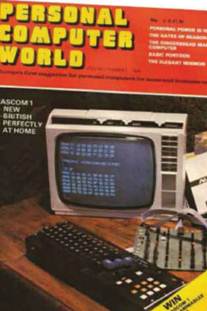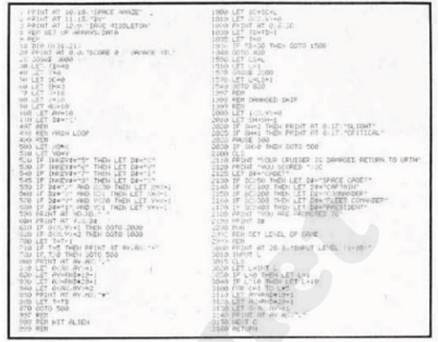Zzap!64 writings
As with Crash,
Zzap!64 covered the many games that were released for the Commodore during the
80s on what was considered a far superior 8-bit machine. Top-scoring games were
given gold medal awards. Elite was reviewed in issue 1 and was the first ever
Zzap!64 game to receive one. Good games – those that scored from 80% - were
labelled as ‘Zzap Sizzlers’ and branded with the appropriate logo. The reviews
were conducted in the same humorous, bordering cheesey, style which still works
today.
The reviewers
never took themselves too seriously, they played computer games and wrote about
it. If they were war correspondents, then naturally they would have to adopt a
serious tone to their scribblings, but let’s face it, they had what has always
been considered the ultimate job and they certainly had fun doing it. As well
as giving high praise to those games that deserved it, the writing team weren’t
afraid to dish out a little summary justice from time to time, often scoring as
low as 6% for some ‘very special’ titles and adding comments such as ‘Whoops!
Who let this one out of the home?’ and ‘lousy, disgusting and mediocre. I’m
ashamed.’ You just don’t see comments like this any more.
Aside from the games
reviews, you got a healthy mix of previews, latest news, tests and features
that covered how to make games music, how to move a sprite and so on, called
Zzap One Offs. The tips pages usually featured a full colour map to some game
or other, and as with Crash and other magazines at the time, the tips were
generally sent in from avid readers who had somehow managed to beat the game
into submission.
A semi-regular
column written by the legendary Jeff Minter (he of Llamasoft) caused the odd
flare of controversy every once in a while. Jeff’s unorthodox style and passion
often got the better of him, once likening the Zzap reviewers to ‘mutants’ and
describing their writing style as ‘puerile’. Personally, I always liked Jeff’s
take on the 8-bit world.
Zzap Amiga
Eventually, as the
Amiga started to take off, these hi-end machines began to take a more permanent
role in the pages of Zzap, which ultimately changed the title to Zzap!64 Amiga
on issue 43. This only lasted until issue 66, when the Amiga part was dropped,
then Zzap!64 continued until its demise in issue 90, after which the magazine
was laid to rest and replaced by Commodore Force. And end of an era, but not
bad going for a 95p magazine with 132 pages of C64 glory.
Where are they now?
With the C64 still
being the behemoth 8-bit wonder, there are several sites dedicated to the
mighty Zzap!64; all you need to do is search for them. Chris Anderson, the
original editor, founded Future Publishing and is the curator of TED
(Technology, Entertainment, Design). Julian Rignall, another editor, is now the
vice president of GamePro Media and although most of the writers have either
dropped into obscurity or have gone on to higher things, there is the
occasional ghost from the past who surfaces on the likes of Twiiter, long
enough to be recognised.
PCW
Next up is a
computing magazine that has to be one of the longest-running mags ever.
Personal Computer World was its name, and it started life way back in 1978,
when most of us were nowt but tousled-haried sprogs, with ringworm and rickets.
PCW was created in a time when PCs were assembled by electronics enthusiasts
who liked nothing better than to attack a project with a screwdriver and
soldering iron, but who also say a future in what many regarded as a flash in
the pan fad.
Founded by Angelo
Zgorelec, this monthly magazine would see such amazing changes in technology
over its lifetime that they would shock the senses. Being launched four years
before the first IBM PC gave this magazine a unique stance – quite literally it
was there when everything started to change for the world of personal
computing.

PCW, the first issue, note
the beast of a computer on the cover.
Early years of PCW
Zgorelec was, at
the time, running a newsagent in London. It occurred to him that rather than
selling these publications, perhaps he should be making his own. As technology
was beginning to gather pace in the public eye, and with a post in the Wall
Street Journal predicting that computers would one day rule the world, Zgorelec
decided to take a gamble. After visiting a computer fair in New York, in which
he had to queue for two hours just to get in, he returned to blighty with a big
idea forming, and as a result, PCW was born.
The first issue
coincided with the release of the NASCOM-1, a single-board computer kit that
cost whopping $300, had a 2MHz CPU, 2KB of RAM and proved to be such a popular
unit that PCW sold out of the initial 30,000 copy limit within a week.
After that, PCW
became the early enthusiasts magazine, covering every aspect of those
prehistoric self-build machines until at last the first pre-built personal
computer started to emerge and the technology playing field was altered
forever.

PCW’s Sinclair chimp.
Wonder where he is now?
PCW Content
During the golden
era of the 80s, when there were more home computers than you could possibly
imagine, PCW became a constantly evolving beast. It covered not just the big
giants in the tech world, but also the machines released by those smaller
companies who eventually disappeared, almost overnight.
This became the
standard that PCW would maintain throughout the decade, printing programming
code, which readers would happily spend hours entering into their systems;
showing technical diagrams of every possible system; providing early benchmarks
when comparing and testing the new computers that sprang up like mushrooms. The
magazine covered software, games, coding, book reviews, news interviews with
prominent members of the tech society – if it plugged into the wall and/or was
classed as ‘technical’ the magazine would review and dissect it. The front
covers were designed to stand out from the overcrowded news-stands, usually
with a large image printed below the bold type ‘Personal Computer World’, and
they mostly followed a theme. For example, whenever a Spectrum was printed, it
showed the machine with a chimpanzee dressed to match the type of Spectrum (a
bowler-hat-wearing chimp for the Sinclair QL, or with a beret and artists easel
for the 48K). The writers certainly delved into the intricacies of their
assignments, dedicating several pages of content to a particular review.
Whether that’s a good thing or not, I’ll leave for you to decide – apparently,
Chris Cain wrote a three-page review on a Logitech Mouse.

A classic example of
content, line upon line of Basic
PCW, the end
As with the
previous magazine, PCW finally closed its pages in June 2009, quoting poor
sales and a difficult climate in which to sell print. Much like our very own
Micro Mart, the readers and contributors were a passionate bunch who loved
technology in its many forms.
Where are they now?
Good question.
Angelo Zgorelec hosts and writes, with his daughter, Anna, the Visit Croatia
website. Gordon Laing, one of the former editors of PCW, now edits Camera Labs.
As for the many writers, contributors and readers, they went out into the
technology world and no doubt prospered.
And finally
Unfortunately,
that’s all we can fit in. there are tons more magazines out there that used to
fill the news-stands and had many a teenager techy drooling over. I hope you
enjoyed this little flashback; I certainly did and it made me think of the
magazines we have these days, and how we must try to protect them as much as
possible, so that one day we can look back to issue one while thumbing through
the pages of issue 9999.
Other Mags
These three are
just the ones that we could fit in the pages of this feature. There were,
however, countless other magazines out there, dedicated to bringing you the
latest from this new wonderland known as technology. Here are some notable
mentions, which are gone, but certainly not forgotten:
C&VG – Computer & Video Games, ran from 1981 to 2004. It’s now
totally web based.
Popular
Computing Weekly – ran from 1982 to 1989, and
covered virtually everything.
Computing Today – ran from 1979 to 1987, it was a very popular magazine at the
time.
Commodore User - ran from 1983 to 1990. CU was a very cool magazine.
Amtix! - ran from 1985 to 1987, it was a magazine for Amstrad computers
from the maker of Crash.
The Games
Machine - ran from 1987 to 1990 and reviewed the
new wave of consoles.
Big K - ran from 1984 to 1985, a multi-format mag, which wasn’t very
popular (I have all 12 issues)
As I said, there
are loads more. Have a browse for them, it makes for interesting reading.